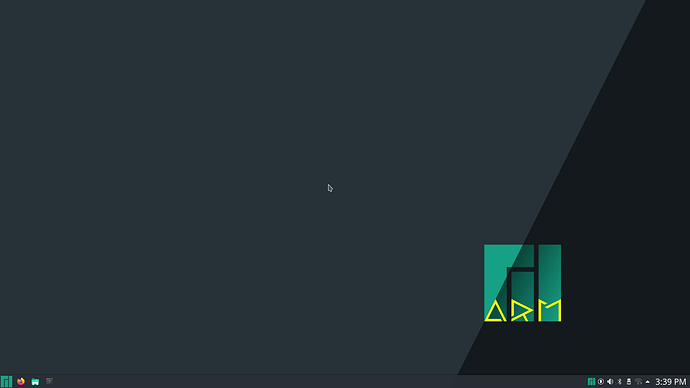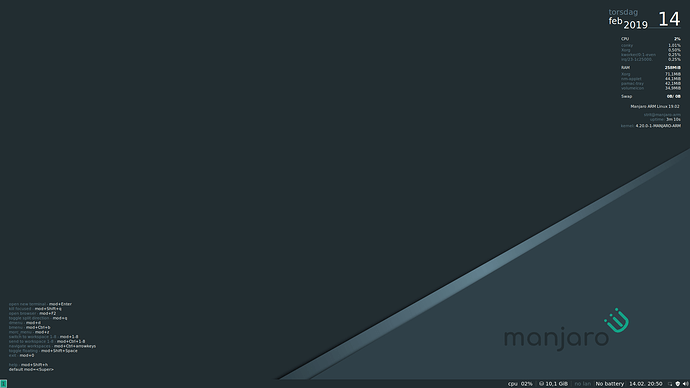Manjaro ARM 20.10 released!
We are proud to announce the release of Manjaro ARM 20.10, which is now available through the new Manjaro ARM Flasher tool.
Currently we have download images for: Raspberry Pi 4, Rock Pi 4B, RockPro64, Khadas Vim 1, Khadas Vim 2, Pinebook and the Pinebook Pro.
Manjaro ARM is proud to also now be the default installation on the Pinebook Pro from Pine64.
We have put in a lot of work to get to this point and we are excited that we have been accepted by the creators of this laptop, as a great OS option.

PinePhone Manjaro Community Edition
New application for flashing images
We have been working on a new GUI app to make it easy for users to flash a Manjaro ARM image on to an SD card or eMMC card.
Simply install manjaro-arm-flasher and launch the app “Manjaro ARM Flasher” from your menu. This will download and flash the image of your choice.
You can also manually run the application (if you are not running Manjaro ARM) by downloading this python script, make it executable with chmod +x manjaro-arm-flasher and then run it with sudo ./manjaro-arm-flasher. It requires python-blkinfo 0.1.3 to be installed, which can be installed with pip install blkinfo.
This software is still in early development and does not include all the features we want yet.
First Time setup
This release sports the First Time setup for all images, also via SSH. This means that at first boot, you will be asked about the following:
- keyboard layout (except on pinebook, that is fixed to us layout)
- username
- additional user groups (optional)
- full name
- password for that username
- password for root
- timezone
- locale
- hostname
Then the setup script will set these settings and reboot to the login screen.
Screenshots
XFCE
KDE Plasma
i3
Sway
Downloads:
| Device | XFCE | KDE Plasma | i3 | Sway |
|---|---|---|---|---|
| Raspberry Pi 4 | 20.10 | 20.10 | 20.10 | 20.10 |
| Pinebook Pro | 20.10 | 20.10 | 20.10 | 20.10 |
| Pinebook | 20.10 | 20.10 | 20.10 | 20.10 |
| Rock Pi 4B | 20.10 | 20.10 | 20.10 | 20.10 |
| RockPro64 | 20.10 | 20.10 | 20.10 | 20.10 |
| Khadas Vim 1 | 20.10 | 20.10 | 20.10 | 20.10 |
| Khadas Vim 2 | 20.10 | 20.10 | 20.10 | 20.10 |
Torrents are also available!
Features:
- New packages from upstream and Manjaro ARM.
- Manjaro now uses a branch based repo structure. Meaning you can now switch between
stable,testingandunstablebranches by running this command:sudo pacman-mirrors -aS <branch>. - All new installations use a 2 partition layout and use extlinux.conf where applicable. Devices not using extlinux are Raspberry Pi 4, Odroids and Khadas devices.
- Introducing the
manjaro-arm-flashertool, which can be used to download and flash an image to any drive. - XFCE 4.14
- KDE Plasma 5.19
- The Raspberry Pi images can now also be booted from USB Sticks, if you have updated your EEPROM to the latest release.
Updating from 20.08:
- Audio cards are now present in Odroid N2 and Khadas Vim 3 devices when using
linux-vimkernel. - Audio card is now present on Odroid C2.
Known issues:
- No audio cards on Odroid C4 and Roc-CC.
- Bootsplash does not work on Raspberry Pi devices.
- Lid Close trigger on the Pinebook Pro and Pinebook does not work on the XFCE edition.
Tips and Tricks:
Smoothness on Raspberry Pi 3 devices:
To get a smoother experience on your Raspberry Pi 3 device, while running the Raspberry Pi 4 image do this:
- Install
xf86-video-fbturbo-git. - Edit
/boot/config.txtand comment outdtoverlay=vc4-fkms-v3dandmax_framebuffers=2. - Save the file and reboot.
Supported Devices:
Images:
- Khadas Vim 1 (maintained by @spikerguy)
- Khadas Vim 2 (maintained by @spikerguy)
- Pinebook
- Pinebook Pro
- Raspberry Pi 4 (tested on B, also works on Raspberry Pi 3) (maintained by @darksky)
- Rock Pi 4B
- RockPro64
With Manjaro ARM Installer (in addition to the above devices): (Download it here)
- Khadas Vim 3
- Khadas Edge-V Pro
- LibreComputer ROC-RK3328-CC
- NanoPC T4
- Odroid C2
- Odroid C4
- Odroid N2
- Odroid N2+
- Pine64-LTS
- Pine64+
- Pine-H64
- Rock64
- Rock Pi 4C
What about other devices?
Manjaro ARM no longer supports the armv7h architecture. So if you have/use an armv7h device, you should be looking at other distro’s. Some could be:
- Arch Linux ARM
- Armbian
- Raspbian (for the raspberrypi)
- Ubuntu Mate
- Parabola
The armv7h repo has been removed from the repo server and mirrors.
We won’t be making images for all the supported devices. If your desired image for your desired supported device does not exist, please use manjaro-arm-installer to install it to an SD/eMMC card.
Alpha images for PinePhone and PineTab are available with Phosh, Lomiri and Plasma Mobile.
Donation
Please consider supporting Manjaro ARM directly via Patreon, Ko-Fi or Open Collective.
You can also donate to our upstream, which is Arch Linux ARM.



